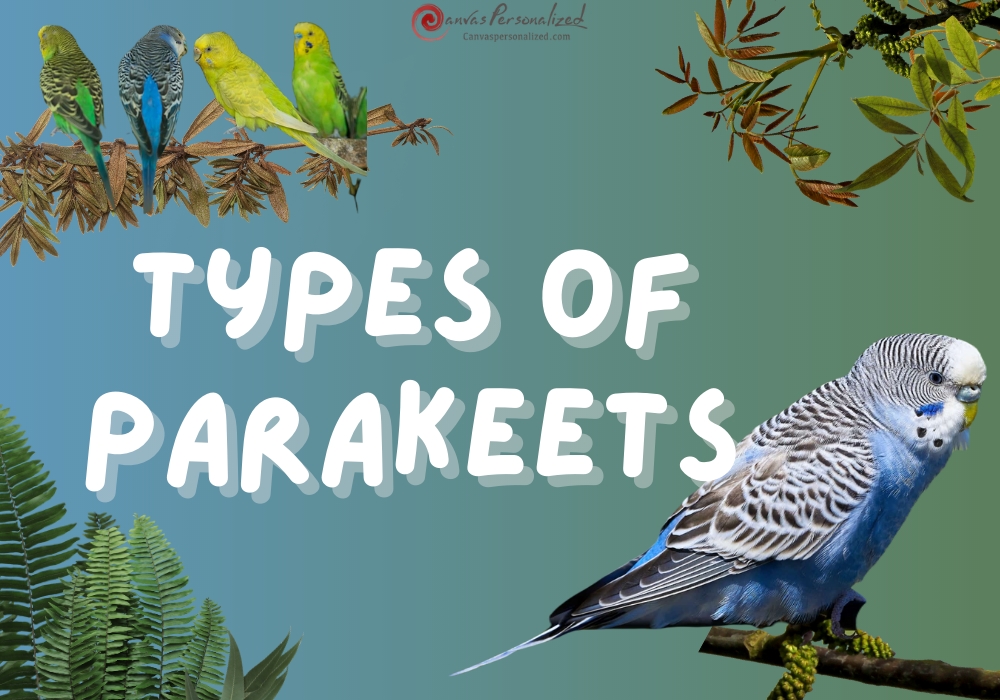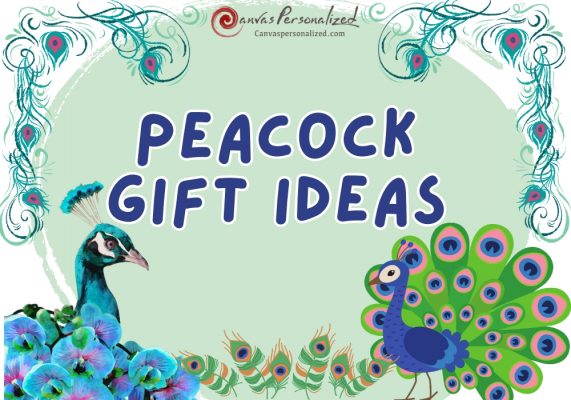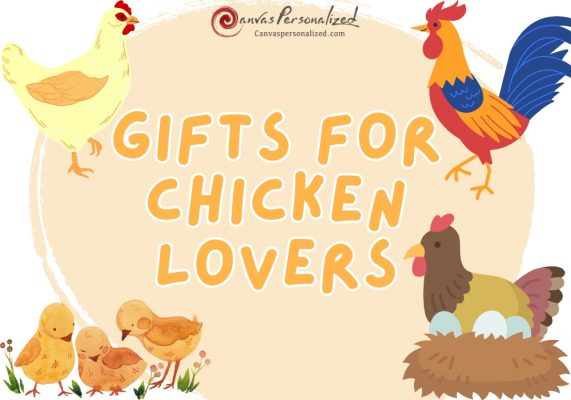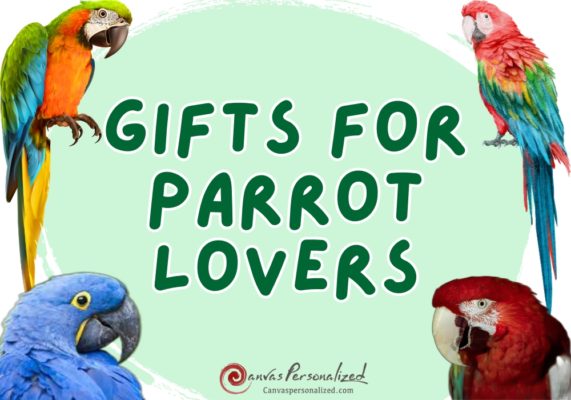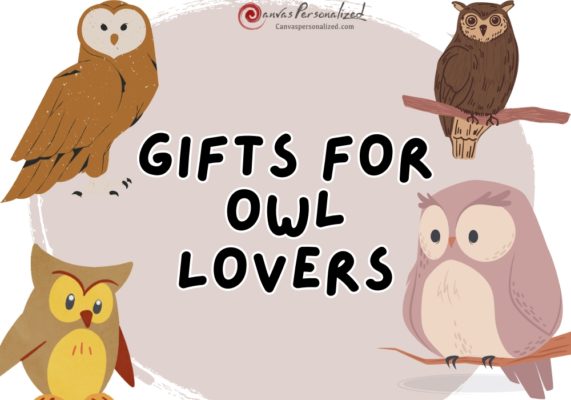We’ve all seen pet store parakeets with bright colors flitting about. They draw attention because of their complex designs and patterns. If you’re considering adding a parakeet to your family, you may wonder which parakeet species best suits your lifestyle. Here, Canvas Personalized Blog will explore the different types of parakeets and what makes each one unique.
What Are Parakeets?
The name “parakeet” refers to a diverse group of parrots smaller than Macaws, Amazons, and Cockatoos. These birds are characterized by long tail feathers and thin bodies. In addition to the common parakeet, several types of parrots, such the mustache parakeet, grass parakeet, Monk parakeet, and Indian Ring-necked Parakeet, are also commonly referred to by this name.
Parakeets are small to medium-sized parrots, but that doesn’t mean all small to medium-sized parrots are parakeets. The group of parakeets is vast, with many different breeds with different traits. Some birds, though, are not in this group ( such as Lovebirds, Pionus, Eclectus,…).
Finding Out About the Different Types of Parakeets
1. Budgerigar
- Scientific Name: Melopsittacus undulatus
- Adult Size: 5 to 11 inches
- Lifespan: 5 – 8 years
- Average price: 10$ – 35$

Budgerigars are popular as pet birds. They are also called budgies or parakeets. The small, colorful parakeets come from Australia, where they are known for being playful and easy to care for.
Budgerigars are primarily green, yellow, and blue in their natural habitat. But because of modern breeding, they can be many different colors now.
Because they are friendly and curious, these guys are popular as pets. Budgerigars should always be kept in groups of at least two. They depend greatly on their flock, so they need other birds to play with, groom, and cuddle with.
2. Plain Parakeet
- Scientific Name: Brotogeris tirica
- Adult Size: 9 inches
- Lifespan: 10 – 15 years
- Average price: 50$ – 100$

Their look is plain, as their name implies. They are also one of the most plain-looking types of parakeet kept in captivity. But no matter what, you can’t deny that they look cute. Both adults are all green, but the wings and back are darker. Although being a single hue, its body’s green intensity varies greatly.
Plain parakeets’ gentle, sociable natures often leave their human caretakers in awe. They may be reserved with new people, but they adapt well to living with their human companions. It’s common to pay anywhere from $50 to $100 for a plain parakeet.
3. Monk Parakeet
- Scientific Name: Myiopsitta monachus
- Adult Size: Between 11 and 12 inches
- Lifespan: 20 – 30 years
- Average price: 600$ – 700$
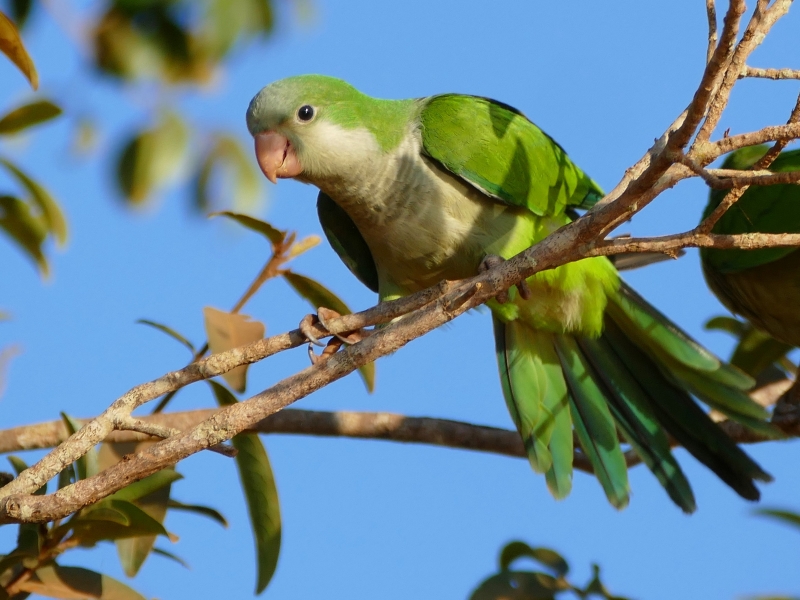
The monk parakeet, also called the Quaker or clown parrot, is well-known for being friendly, energetic, funny, and charming.
This vividly green parrot has a grey breast and a yellow to green abdomen. They have white eye-rings that starkly contrast to the black eye stripe that runs from eye to cheek. Natural habitats for this species may be found in South America.
Caring for these small birds requires much time and effort, so not everyone can keep one. But they are an excellent choice for anyone who likes birds because they are hilarious and theatrical birds.
4. Derbyan Parakeet
- Scientific Name: Psittacula derbiana
- Adult Size: 18–19.6 inches
- Lifespan: Up to 30 years
- Average price: 400$ – 1000$
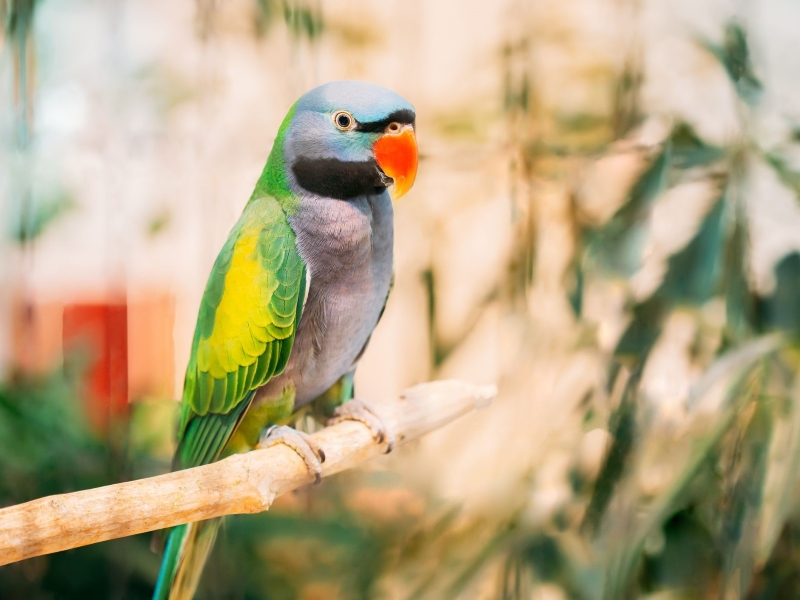
The striking color patterning of the Derbyans makes it an exciting types of parakeet. They are largely green, save for the bluish-gray of their heads and chests and the two deep, defining black bands across their eyes and chin. Their wings’ upper and lower feathers may both feature bright yellow spots.
Despite their vivid hue, they have easygoing natures and make great friends. These birds love to learn and can absorb information rapidly.
5. Indian Ring-Necked Parakeet
- Scientific Name: Psittacula krameri manillensis
- Adult Size: 16 inches, 4 ounces
- Lifespan: 25 to 30 years; in some instances, up to 50 years
- Average price: 400$ – 500$
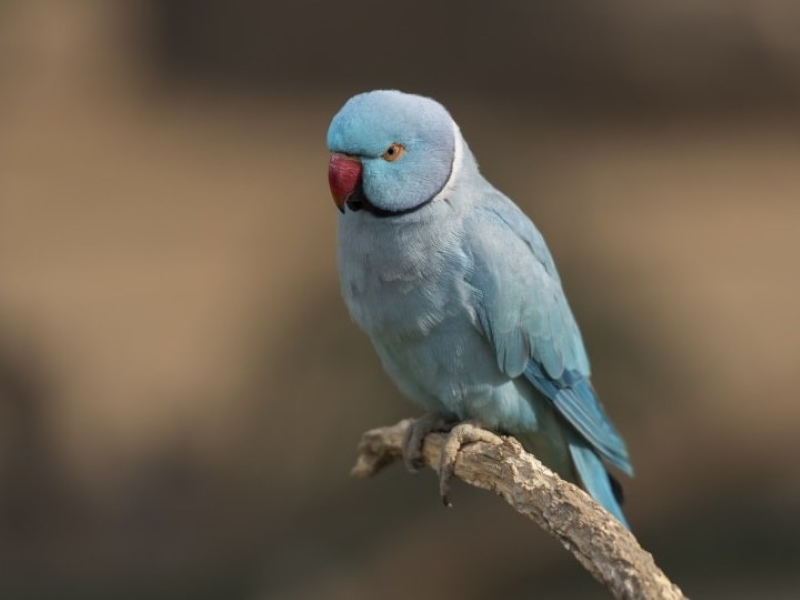
Several types of ringnecks can be found in various colors, from albinos and lutinos to vivid greens and blues. Though color variations are widespread, this species is usually vivid lime green with blue tail feathers and yellow under the wings.
They are a species called “dimorphic,” meaning that the birds’ colors and markings can show which gender they are. Males have dark red beaks, black face markings, and three neck bands. Females, while still stunning, do not have the bands on their faces or collars. However some do show a deepening of color at the base of their necks.
The Indian ring-necked parakeet has a bad name because it is known to be a moody and difficult bird. It has a reputation for being hard to train and a little snappy, but this isn’t true. They get bored quickly because they are so smart. When this happens, they do become a little bit dangerous. Chewing is the common consequence of these cases.
6. Alexandrine Parakeet
- Scientific Name: Psittacula eupatria
- Adult Size: 22 – 24 inches
- Lifespan: 30 – 40 years
- Average price: $500 to $1,500

Both male and female Alexandrine parakeets are mostly green and have big red beaks. Their bellies are yellow, their heads are blue-gray, and they have a red patch on their shoulders. The pink and black ring around the necks of males makes it easy to tell them apart from females.
This species also comes in different colors, which can happen naturally or be made on purpose by breeding the Alexandrine parakeet with the Indian ringneck parakeet.
It’s simple to see why Alexandrine parakeets have been beloved household pets since Ancient Greek times; they’re both playful and loving. These birds are smart and active, can learn tricks, and are a lot of fun to live with. They’re also good at talking and can learn a lot of words. Alexandrine parakeets are loyal pets that form close bonds with their owners.
7. Plum-Headed Parakeet
- Scientific Name: Psittacula cyanocephala
- Adult Size: 12 inches, weighing 2.3 to 2.8 ounces
- Lifespan: 15 – 20 years
- Average price: $400 to $700

Male and female plum-headed parakeets look different because of sexual dimorphism. Green makes up the majority of both sexes’ bodies. The males have bluish-purple heads that are highlighted in black at the throat. Unlike males, females lack the black neck stripe and have blue-gray head feathers. Instead, you’ll see that many have yellowish feathers around their necks.
Plum-headed parakeets are usually kind, friendly, and affectionate with their owners, but they can be shy around strangers. They are pretty quiet for a parrot. So they might be a good choice for bird owners who live in apartments or other places with close neighbors.
8. Scarlet-Chested Parakeet
- Scientific Name: Neophema splendida
- Adult Size: 8 inches long and weighs about 2.5 ounces
- Lifespan: 10 – 15 years
- Average price: $250 to $300
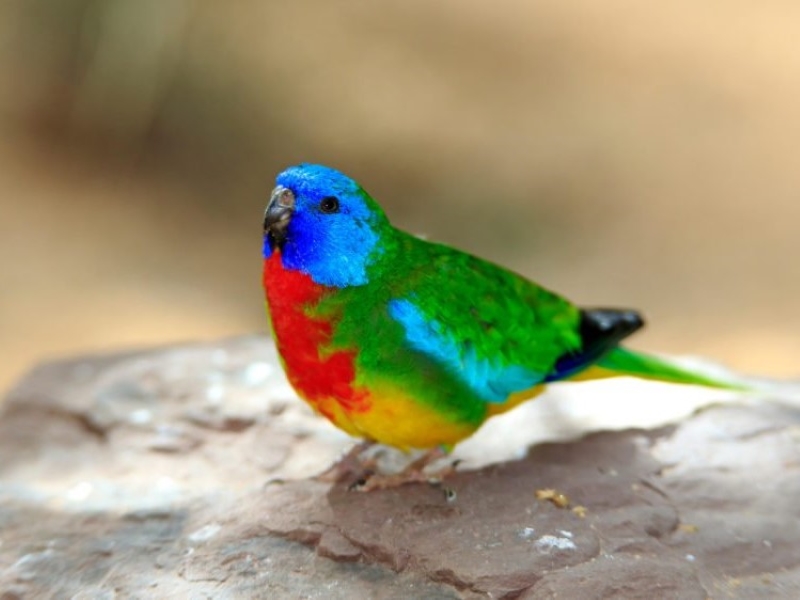
Scarlet-chested parakeets have feathers in every color of the rainbow. Their species is sexually dimorphic, meaning that men and females look different.
Dark blue cheeks, red chests, vibrant green backs and crowns distinguish scarlet-chested parakeets, especially mature males. Their brilliant blue underwing feathers and bright yellow bellies set them apart. Females with mature heads have less blue and more brown. Yet, they have green wings, backs, and chests like males.
The calm and sociable nature of the Scarlet Chested Parrot is often at the heart of its popularity as a pet. They get along great with other smaller birds and are known for their friendliness. Instead of screaming or making loud contact calls, scarlet-chested parakeets prefer to quietly converse with one another. They are also great for people living in small apartments because of their size.
9. Bourke’s Parakeet
- Scientific Name: Neopsephotus bourkii
- Adult Size: 7 to 8 inches
- Lifespan: Up to 25 years
- Average price: $100 – $300
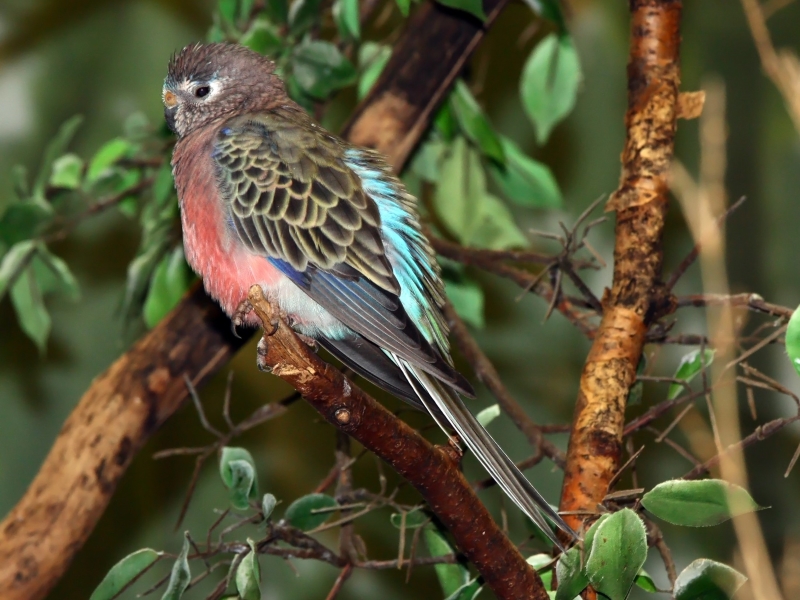
Bourke’s parakeets are striking, despite their lack of eye-popping coloration compared to certain other species. Pink breast, belly feathers, and blue wing tips break up its dusty brown plumage. They have a deeper brownish-gray color on the backs of their wings, with lighter outlines highlighting each feather.
The Bourke’s parakeet has the potential to undergo several different color mutations. The bright pink Bourke’s parakeet is one of the most popular.
Bourke’s parakeets are lovable, docile birds that form strong attachments to their human caregivers through hand-feeding as young. These birds have a high IQ but are much more laid back and quiet than other parrots. They are friendly and like company, so don’t be surprised if one hops on your shoulder occasionally.
Parakeet’s Care Requirements
Diet & Feeding
A parakeet’s diet should include all of the following:
- Around 60% – 70% of your parakeet’s diet should consist of pelleted food made especially for them, while the other 10 – 20% should be made up of fresh produce, fruit, and fortified seeds.
- Daily changes of clean, fresh water
- Do not give birds avocados, fruit seeds, chocolate, caffeine, or alcohol. These things are poisonous and can make birds sick or even kill them.
- Avoid treats that are high in salt and fat.
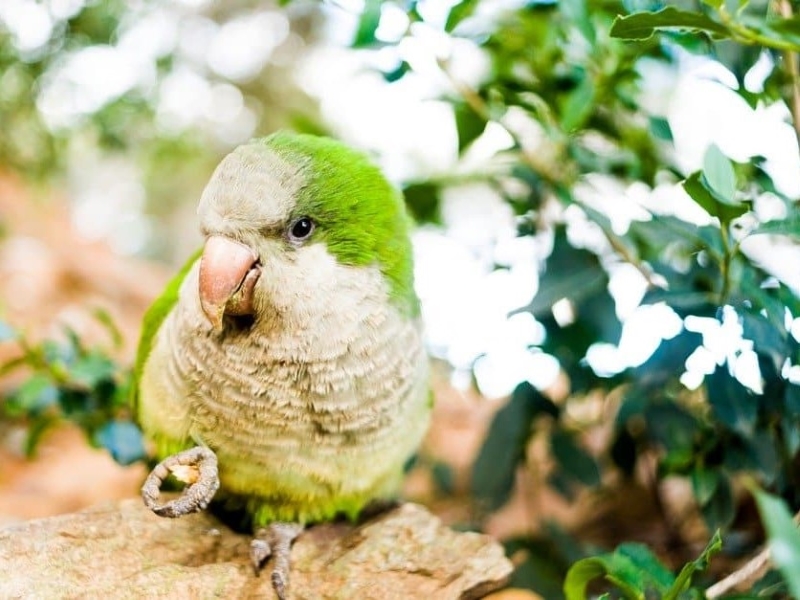
Important considerations for parakeet nutrition:
- At all times, there should be enough of fresh food and water.
- Fruits and vegetables left out for over a few hours should be thrown away.
- Sweets and snacks should not account for more than 10 percent of daily calories.
- Parakeets don’t need to be given grit to grind food in their stomachs since they remove the hulls from seeds before eating them.
Grooming
- Birds need to be groomed regularly, and every few weeks to months, their nails should be cut by a professional so the bird doesn’t get hurt.
- Unless a bird has a condition (such liver illness) that causes aberrant beak development, it should not need frequent trimming. Beaks in birds generally retain a decent condition with everyday use.
- See an avian veterinarian for advice on clipping your bird’s outermost five flight feathers to avoid damage or escape.
Common Heath Issues
Psittacosis is a disease that may be passed from birds to people and has been seen in parakeets. Infection with this bacterium leads to breathing difficulties, but may be remedied with medication. Parakeets are susceptible to viruses that can trigger symptoms, including diarrhea, pneumonia, and feather issues.
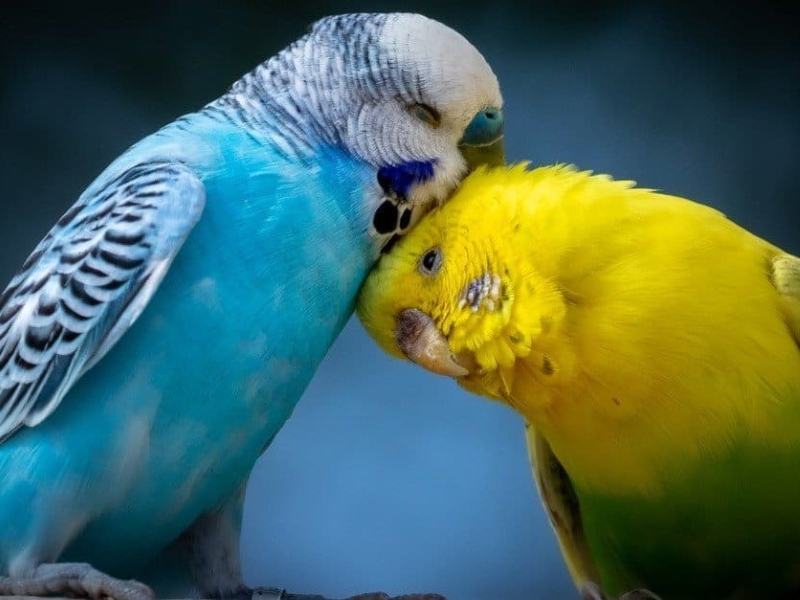
The Aspergillus fungus often brings on nasal congestion in parakeets, but it may be avoided with the right diet and cleaning routine.
Parakeets can fall victim to a variety of parasites. Feather loss and mood swings might result from an infestation of external mites and lice, while an intestinal infection can bring on weight loss and depression.
How To Buy Or Adopt A Parakeet
To ensure the health and happiness of your adopted parakeet, you should spend time each day playing with and socializing with it. Bored and depressed parakeets might have physical and behavioral problems if left alone. Care for one of these birds properly, and you’ll have a loyal buddy at your side.
Contact your local aviculture society and talk to some breeders and experienced bird owners about the types of parakeets you are interested in. These experts can help you determine which species would work best with your lifestyle.
| Name | Website | Number |
| The Finch Farm | www.thefinchfarm.com | (877) 527-5656 |
| Lone Palm Birds | www.lonepalmbirds.com | (239) 877-1191 |
| Cutie Pie Birds | www.cutiepiebirds.com | (512) 981-9222 |
| Birds By Joe | www.birdsbyjoe.com | (818) 577-4141 |
>> Other related posts that you may be interested in:
- 400 Best Bird Names For Your New Companion: Tips And Ideas
- The Ultimate Guide To Types Of Conures: Which One Is Right For You?
In conclusion, there are many types of parakeets, each with unique traits. Whether you’re a beginner or an experienced bird owner, there is a parakeet that will fit your needs and tastes. By researching and finding a reputable breeder, Canvas Personalized Blog can ensure that your new feathered friend will bring you years of happiness and companionship.


